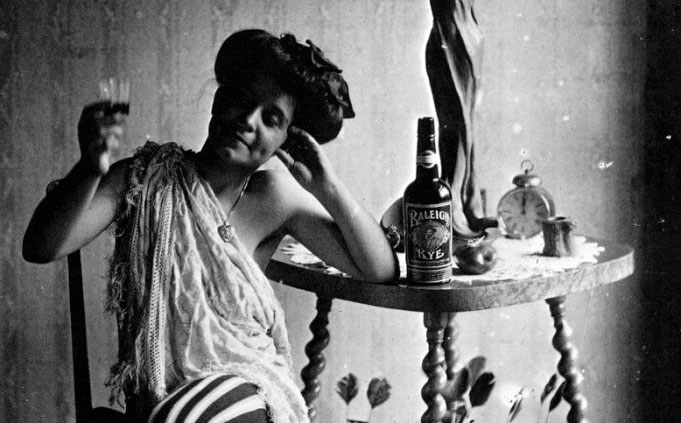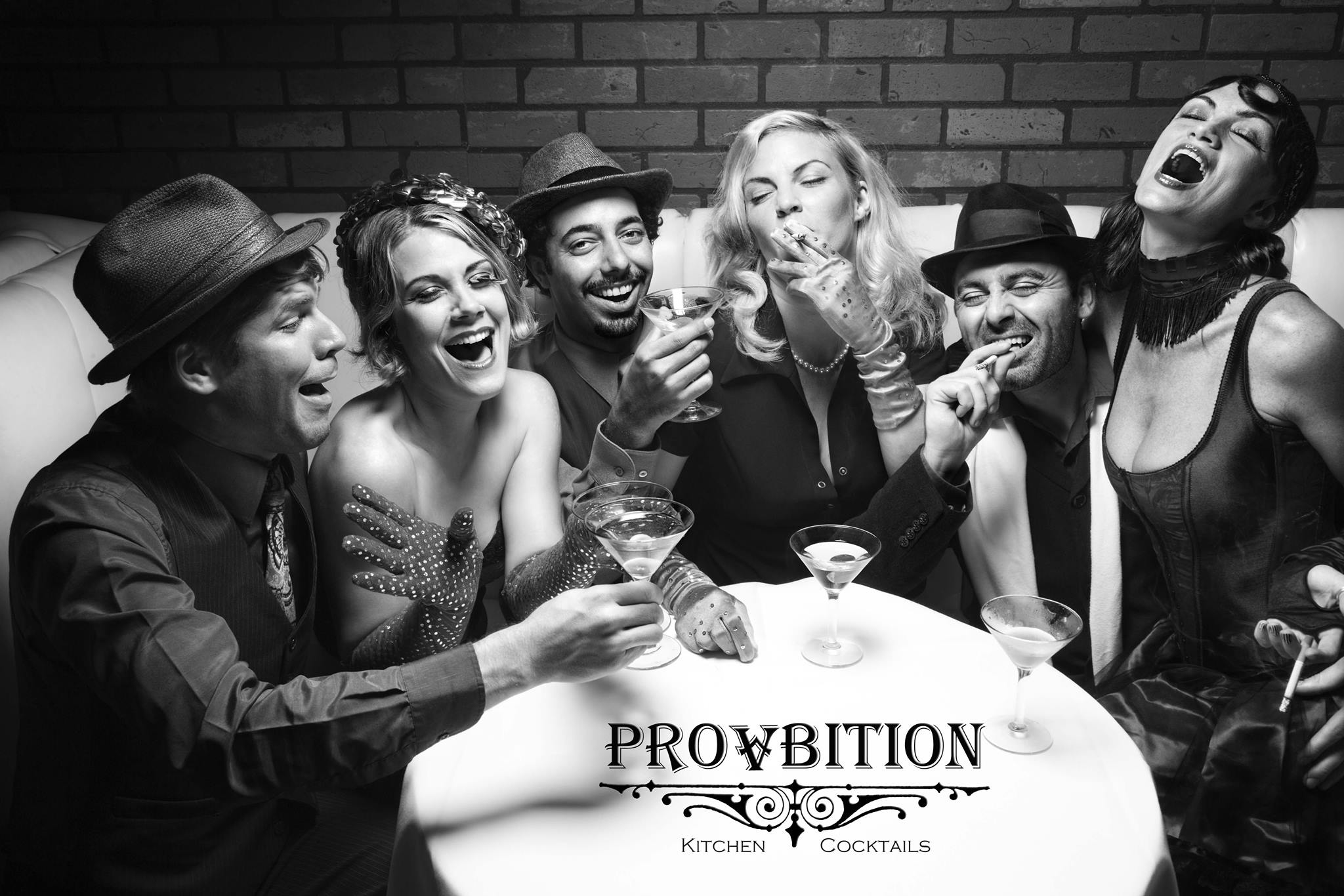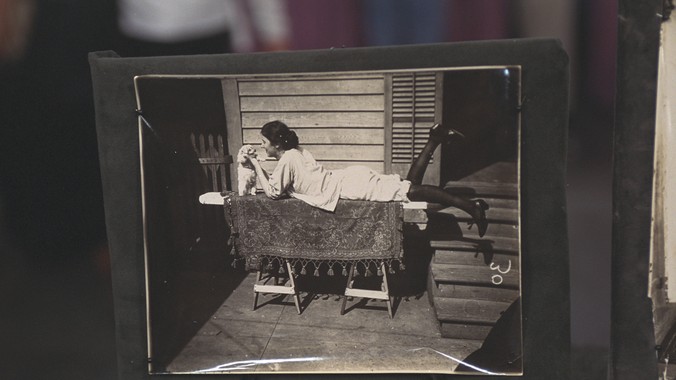“You can make it illegal, but you can’t make it unpopular”
– New Orleans Mayor Martin Behrman [1904-20, 1925-6]
The R.W. Norton Art Gallery is practicing some boundary testing, and inviting the curious to come along. Scarlett Passions, Bellocq’s Storyville, the Norton’s raciest exhibit to date, opens October 22 with Speakeasy: A Prohibition Party, which promises a good time for those seeking strong booze, soulful jazz, and loose women.
Note: beverage “strength” adjustable to individual taste, good jazz has been rumored to really affect a person, and the only loose women referenced above are those displayed in Bellocq’s photographs.
This swanky speakeasy event will be catered by Ernest’s New Orleans Restaurant, and the Norton’s basement (which is normally not opened to the public) will become the downstairs den for vintage magic, juggling, and vaudeville shows performed by the Marvelous Misfits.
“The Norton has never before exhibited subject matter like this, and some have voiced concern that it may be a bit too racy,” stated Emily Feazel, Head Designer of Exhibits and Events at the Norton, who created Scarlett Passions: Bellocq’s Storyville by adding different frame styles and a variety of print sizes to make the exhibit feel more like a home and an immersive experience, and less like just another installation. Feazel was inspired by the home feel captured in Bellocq’s photos, which show the living and working spaces of Storyville prostitutes. The walls of the brothels displayed photos of children alongside photos of salacious acts. The wallpaper in the exhibit is reminiscent of the early 1900s and the red-light district’s forbidden charm, creating the illusion of opulence while obviously preferring function over frivolity.
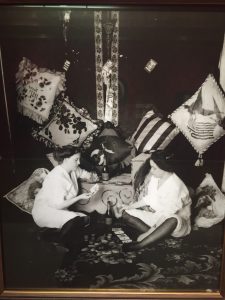 Like all art, beauty is in the eye of the beholder, not everyone will find value in E. J. Bellocq’s photographs of prostitutes in the infamous New Orleans red-light district Storyville, but for those interested in exploring and expanding your perspective on an import historical era, those willing to challenge previously held beliefs about a practice often described as deplorable, illicit, and immoral, and those who generally appreciate great photography and artistic work, please come in and join us.
Like all art, beauty is in the eye of the beholder, not everyone will find value in E. J. Bellocq’s photographs of prostitutes in the infamous New Orleans red-light district Storyville, but for those interested in exploring and expanding your perspective on an import historical era, those willing to challenge previously held beliefs about a practice often described as deplorable, illicit, and immoral, and those who generally appreciate great photography and artistic work, please come in and join us.
This exhibit is not just unique for its subject matter. The Norton does not currently house any photography in its permanent collection, making this exhibit unique by medium as well. The inspiration for Scarlett Passions was sparked by Bellocq’s lady with stripped stockings, and diligent research by the Norton staff recovered 67 of Bellocq’s photographs of Storyville women, but the current exhibit was narrowed to display 31 photographs printed by the Norton, and beautifully framed by Wadell’s. Research was led by Everl Adair, Director of Research and Rare Collections, and includes quotes from notorious Storyville figures and entertaining narratives about the place and time. Interestingly, while researching Bellocq’s body of work, Norton staff uncovered that no one owns a copyright for the reproduction of his work.
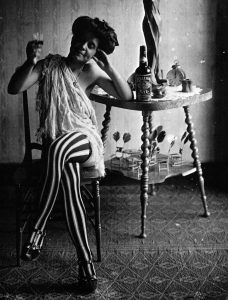 One of my favorite anecdotes included in the exhibit references the problem of “well to-do women” slumming. Apparently, some wealthy women wanted to experience life on the other side, and a boisterous New Orleans Madame quickly put this practice to an end. Prostitution was formerly a valued profession, economically profitable, socially fascinating, and a way of life for many women. As I walk through the Scarlett Passions exhibit, I experience Bellocq’s great respect for his models. He has captured the beauty of their lives, the essence of their personality, and sheds light on a past-time, some have attempted to hide in the dark.
One of my favorite anecdotes included in the exhibit references the problem of “well to-do women” slumming. Apparently, some wealthy women wanted to experience life on the other side, and a boisterous New Orleans Madame quickly put this practice to an end. Prostitution was formerly a valued profession, economically profitable, socially fascinating, and a way of life for many women. As I walk through the Scarlett Passions exhibit, I experience Bellocq’s great respect for his models. He has captured the beauty of their lives, the essence of their personality, and sheds light on a past-time, some have attempted to hide in the dark.
I left the Norton contemplating the lives of women 100 years ago. Bellocq has captured memories of sisters working side-by-side, mothers bringing their children to work, women bringing their dogs to work, and women living and working in a shared space. I also considered that madams were strong community leaders and some of the first female entrepreneurs. Of course life wasn’t perfect then, as it isn’t now, but in Shreveport, I’d like to see more sisterhood, daycares in workplaces, shared working and living spaces, and I want to bring my dog to work. We should consider the lessons of the past as we attempt to shape our future. The Norton has brought us a fantastic opportunity to view Bellocq’s unique perspective of prostitute life in Storyville.
A bit of background before you go…
John Ernest Joseph Bellocq and his photography were introduced to the mainstream artistic community when photographer Lee Friedlander purchased Bellocq’s negatives from an antique-book dealer in New Orleans in 1966. Using the negatives, Lee reproduced the photos through a process of exposing the glass plates to indirect sunlight for a period of 3 hours to 7 days then dipping the paper into a toning bath. Lee’s reproductions in the original 8 x 10 size were displayed at the Museum of Modern Art (MoMA – New York) in 1971. Lee’s exhibit yielded the first edition of Bellocq: Photographs from Storyville, the Red-Light District of New Orleans, a collection of Bellocq’s work printed by MoMA. This month, the Norton’s Scarlett Passions: Bellocq’s Storyville will exhibit enlarged prints of Bellocq’s work which reveal details often unnoticed in the original 8 x 10 reproductions: pictures hanging on walls, items on tables, writing on the labels of bottles, and even the identity of formerly marked women!
As you experience Scarlett Passions, you may notice that the faces of some of Bellocq’s women have been scratched out. These marks were made on the original glass frames. Some have theorized that the faces were scratched out by Bellocq’s Jesuit priest brother, who found the frames after Bellocq’s death. While it is probable that Bellocq did suffer from some form of mental illness, evidenced by his becoming eccentric and reclusive later in life, a more obscure theory has been proposed, claiming the marks made by Bellocq somehow parallel the actions of London serial killer Jack the Ripper. Others claim the marks where made by Bellocq himself, which is most probably true, considering that these marks were likely made before the ink on the original frames completely dried. It is believed Bellocq had relationships with the women he photographed, but as to why Bellocq scratched out their faces, nobody knows.
This writer originally speculated that perhaps Bellocq was protecting the identity of his models because of the widespread distain for their profession, BUT after writing this article, I re-evaluated my perspective, remembering that at the time when Bellocq photographed many of these women prostitution was a legal profession.
Specific to Shreveport…
Our city is rich in history and one of my pursuits during my “Dreamport Adventure” has been to learn as much about Shreveport’s history as I possibly can. When I look out my office window the face of Holy Trinity Catholic Church greets me, prominently displaying the date 1896 (Erection date of current church building). This beautiful church was once neighbor to the brothels and saloon houses which lined Fannin Street and dominated the West Downtown and Ledbetter Heights neighborhoods. Like Storyville in New Orleans, Shreveport had its very own red-light district in which prostitution was legal up until 1917.
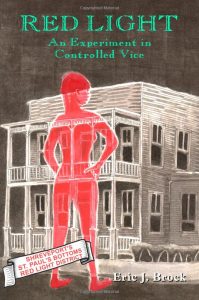 When I first moved here, Brock’s book, Redlight: The history of legal prostitution in Shreveport, was one of the first books I checked out from the library to learn about my new city’s past, along with Wicked Shreveport by Palombo, Joiner, Hale, and White. From the start, I began to see similarities between my old city and my new city.
When I first moved here, Brock’s book, Redlight: The history of legal prostitution in Shreveport, was one of the first books I checked out from the library to learn about my new city’s past, along with Wicked Shreveport by Palombo, Joiner, Hale, and White. From the start, I began to see similarities between my old city and my new city.
Annie McCune, famous Shreveport madam, once owned a brothel adjacent to where the Millennium Studios now stands. McCune is buried in Oakland Cemetery (where I visit often with my dog because it’s one of the only greenspaces in Downtown) not too far away from local celebrity historian, Eric Brock.
One more thing…
Historical context may romanticize prostitution, but today in Shreveport the exploitation of women and children is an issue that has recently been addressed by Heliopolis and other media outlets. Louisiana’s incredibly harsh punishments for those convicted of crimes against nature (which criminalizes solicitation or performance of sexual acts for compensation), was only recently revised for being race and gender discriminatory. The practical problem with these laws was requiring sex offender registration of those convicted, which basically ruined a person’s life by preventing them from ever being able to function in normal society and perpetuating the lack of access to legal employment for those involved in the prostitution trade. The same people are often arrested multiple times for prostitution. It is necessary to talk about how our legal system, misplaced moral values, unconscious bias, and willful ignorance have cast a portion of our population into the darkness.
I encourage everyone to visit the Norton Museum and the Scarlett Passions exhibit. Bellocq’s Storyville photographs challenge us to reconsider how we feel about prostitution, both in the past and the present, we must remember these women are humans – real people, just like you. Bellocq’s work does a beautiful job reminding us to see the similarities in other people and other places instead of focusing on negativities and differences.
The R.W. Norton Art Gallery
4747 Creswell Avenue
Shreveport, Louisiana 71106-1899
Phone: (318) 865-4201
Fax: (318) 869-0435
No admission charge to view the grounds, museum’s art collection, or special exhibitions.
Hours of Operation – Museum
Tuesday through Friday, 10:00 a.m. to 5:00p.m.
Saturday and Sunday, 1:00 p.m. to 5:00 p.m.
Hours of Operation – Gardens
Currently, the gardens are open from 7:00 am – 7:00 pm.
Scarlett Passions, Bellocq’s Storyville is available for viewing Friday, October 21, 2016 – Sunday, December 18, 2016.
Speakeasy: A Prohibition Party
Saturday, October 22, 2016, 6:00 pm – 10:00 pm
Scandal, glamour and risky business. Roaring 1920’s attire is encouraged (Best Costume Contest). Ticket purchase includes admittance, heavy hor d’oeuvres, and one of the three Vaudeville Variety Shows with signature cocktail. Please check show times carefully before purchasing your ticket. To purchase tickets: https://www.eventbrite.com/e/speakeasy-a-prohibition-party-tickets-27283923951
Research:
https://www.icp.org/browse/archive/constituents/e-j-bellocq?all/all/all/all/0
Bellocq: Photographs from Storyville, the Red-Light District of New Orleans
http://www.oaklandcemeteryla.org/Index.aspx
http://www.holytrinity-shreveport.com/history.html

